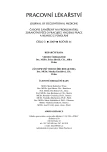Radiation load in health professionals during examination of the sentinel node
Authors:
J. Golisová 1; M. Nakládalová 2
Authors‘ workplace:
Klinika nukleární medicíny FN Ostrava, přednosta MUDr. Otakar Kraft, Ph. D.
1; Klinika pracovního lékařství LF UP a FN Olomouc, přednosta doc. MUDr. Marie Nakládalová, Ph. D.
2
Published in:
Pracov. Lék., 61, 2009, No. 3, s. 109-112.
Category:
Original Papers
Overview
Lymphatic mapping is a relatively new procedure in diagnostics and therapy of some oncological diseases. Detection and marking so called sentinel node is undertaken using an application of radioactive coloid into the tumour tissue. The visualized node is consequently surgically removed and examined. Health professionals are exposed to ionizing radiation at all steps – from lymphoscintigraphy to histological examination of the node. The aim of the study was to measure and evaluate the radiation load of health professionals during these activities. The followed-up sample comprised 100 members of health staff of the department of nuclear mediciny, surgical teams and pathological anatomy. Measurements were undertaken during activities related to interventions on the sentil node in selected types of malignant diseases. The whole body radiation load was measured using an electronic personal dosemeter Isotrak with the possibility of immediate reading of values. The follow-up parameter was the dose equivalent Hp(10). Measured values of the dose equivalent Hp(10) were reaching maximally 6 ĶSv. The conclusion is that the level of radiation load of all follow-up health professionals is very low. However, it is necessary to consider factors which may influence measured values, e. g. applied activity of radiopharmacon, length of particular activites, physical half-life of radionuclids and related timing of a surgical intervention. Measurements proved that radiation load of all exposed professionals was minimal. Concerning the health care of employees we consider appropriate that all exposed employees are regularly and adequately educated on working procedures and safety measures in order to ensure safety and protection of health at work in relation to ionizing radiation.
Key words:
sentinel node, ionizing radiation, radionuclids, radiation load, radiation protection
Sources
1. BETTELHEIM, R., PRICE, K. N., GELBER, R. D. Prognostic importance of occult axillary lymph node micrometastases from breast cancers. International (Ludwig) Breast Cancer Study Group. Lancet, 1990, 335, s. 1565–1568.
2. BOWLES, J., TERADA, K. Y., COEL, M. N. Preoperative Lymphoscintigraphy in the Evaluation of Squamous Cell Cancer of the Vulva. Clin. Nucl. Med., 999, 24, 4, s. 235–238.
3. CABANAS, R. M. An approach for the treatment of penile carcinoma. Cancer, 1977, s. 456–466.
4. FAIT, V., CHRENKO, V., PAPÍRKOVÁ, D. Biopsie sentinelové uzliny v diagnostice a léčbě zhoubných nádorů. Zdrav. Nov. ČR, 2001, 46, s. 23–26.
5. GULEC, S. A., ECKERT, M., WOLTERING, E. A. Gamma Probe-Guided Lymph Node Dissection (ęGamma Picking’) in Differentiated Thyroid Carcinoma. Clin. Nucl. Med., 2002, 27, s. 859–861.
6. HEIDENREICH, P., BARES, R., BRENNER, W. Verfahrensanweisung fur die nuklearmedizinische Wachter-Lymphknoten (sentinel lymph node; SLN)-Diagnostik. Nuklearmedizin, 2001, 40, s. 98–101.
7. HOEFNAGEL, C. A., SIVRO-PRNDELJ, F., VALDÉS OLMOS, R. A. Lymphoscintigraphy and sentinel node procedures in breast carcinoma: role, techniques and safety aspects. World J. Nucl. Med., 2002, 1, s. 45–54.
8. KOLEKTIV AUTORŮ Ochrana při práci se zdroji ionizujícího záření. Ostrava: Dům techniky Ostrava, spol. s.r.o., 2003, s. 64–69, 105–118. ISBN 80-02-01529-0.
9. ELSTON, C. W., ELLIS, I. O. Pathological prognostic factors in breast cancer. I. The value of histological grade in breast cancer: experience from a large study with long-term follow-up. Histopathology, 1991, 19, s. 403–410.
10. PERKINS, A. C, BRITTEN, A. J. Symposium on Sentinel node imaging. Specification and performance of intra-operative gamma probes for sentinel node detection. Nucl. Med. Com., 1999, 20, s. 309–315.
11. PIJPERS, R., MEIJER, S., DIGNUM, P. The sentinel node procedure. Tijdschr. Nucl. Geneeskd., 1997, 19, s. 144–147.
12. GILL, P. G., HALL, V. E., KIRKWOOD, I. Lymphoscintigraphy for locating the sentinel lymph node in patients with breast cancer. Breast, 1997, 6, 1, s. 225.
13. SERA, T., MOHOS, G., PAPOS, M. Sentinem node detection in malignant melanoma patients. Derm. Sug., 2003, 29, 2, s. 141.
14. ULLMANN AstoNuklfFyzika [online]. 2005 [cit. 2008-12-01]. Dostupné na www: <http://www.sweb.cz/AstroNuklFyzika/>
15. WADDINGTON, W. A., KESHTGAR, M. R. S., TAYLOR, I. Radiation safety of the sentinel lymph node technique in breast cancer. Eur. J. Nucl. Med., 2000, 27, s. 4.
16. NOGUCHI, M. Sentinel Lymph Node Biopsy as an Alternative to Routine Axillary Lymph Node Dissection in Breast Cancer Patients. J. Surg. Oncol., 2001, 76, s. 144 –156.
Labels
Hygiene and epidemiology Hyperbaric medicine Occupational medicineArticle was published in
Occupational Medicine

2009 Issue 3
Most read in this issue
- The way we acknowledge occupational diseases of respiratory pathways, lungs and pleura
- Painful impairment of the locomotor apparatus at work in the office
- Professional pneumopathies and current options of rehabilitation treatment
- Analysis of incidence of tick encephalitis as an occupational disease in the Slovak Republic and the Czech Republic in 1989–2008
